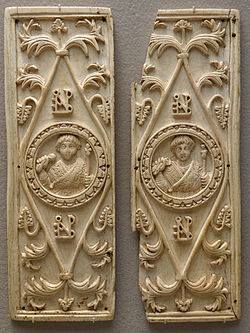Our website is made possible by displaying online advertisements to our visitors.
Please consider supporting us by disabling your ad blocker.
Consular diptych

In Late Antiquity, a consular diptych was a type of diptych intended as a de-luxe commemorative object. The diptychs were generally in ivory, wood or metal and decorated with rich relief sculpture. A consular diptych was commissioned by a consul ordinarius to mark his entry to that post, and was distributed as a commemorative reward to those who had supported his candidature or might support him in the future.[1]
- ^ p178. The origin, context, and function of consular diptychs. Alan Cameron, in memory of Tally Kampen. Journal of Roman Studies 103 (2013) pp. 174–207.
Previous Page Next Page


